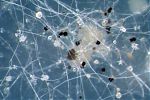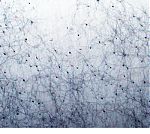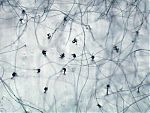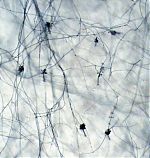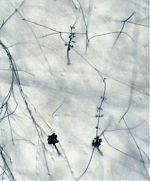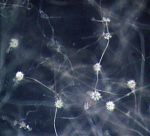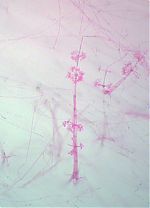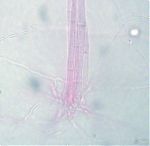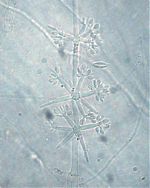Ramicandelaber
RAMICANDELABER Y. Ogawa, S. Hayashi, Y. Degawa & Y. Yaguchi, 2001 (Mycoscience 42:193); 2 spp. (Ogawa et al., 2001; Kurihara et al., 2004).
Mycelium producing stolons that form rhizoids where they contact the substrate. Sporangiophores septate, arise from rhizoids, unbranched, may form supporting hyphae that grow to the substrate and produce rhizoids; fertile branches are borne verticellately, terminating in a fertile apex that may or may not be vesiculate. Sporocladium unicelled, producing a single pseudophialide medially and laterally. Peudophialides globose to hemisphaerical. Merosporangia fusiform, one produced from each pseudophialide; released in a droplet of fluid at maturity. Zygospores unknown.
Type species: R. longisporus
Species of Ramicandelaber:
R. brevisporus Kurihara, Degawa & Tokumasu, 2004 (Mycological Research 108:1145).
R. longisporus Y. Ogawa, S. Hayashi, Y. Degawa & Y. Yaguchi, 2001 (Mycoscience 42:194).
Ramacandelaber spp are typical kickxellalean fungi because they produce the sporocladium-pseudophialide-merosporangium complex, a septum with a lenticular cavity and an included plug, and the spores are released in a droplet of fluid at maturity. These taxa are atypical because they produce stolons and rhizoids and R. brevisporus forms supporting branches that grow down the sporangiophore and terminate in a rhizoid when they contact the substrate (Ogawa et al., 2000; Kurihara et al., 2004). An analysis of 18S sequences of both Harpellales and Kickxellales demonstrated that Ramicandelaber spp. formed a third clade. This possibly indicated that R. brevisporus and R. longisporus belonged in an order of its own (Ogawa et al., 2005). Both species of Ramicandelaber have been isolated from soil (Ogawa et al., 2000; Kurihara et al., 2004). Dr. Kurihara (pers. comm., 2006) stated that Ramicandelaber is more commonly encountered than the other three genera, Mycoëmilia, Myconymphaea, Pinnaticoemansia, recently described.
The isolate of Ramicandelaber brevisporus illustrated here was isolated from soil collected in Gainesville, Florida, U.S.A. Isolation and growth was on one-tenth strength wheat germ agar (Wg10) based on the formula of wheat germ agar described in Benny (1972).
Bibliography
Benny, G.L. 1972. Histochemistry of the cell wall and septum of vegetative cells of selected species of Dimargaritaceae and Kickxellaceae. Mycologia 64: 854-862.
Kurihara, Y., Y. Degawa, and S. Tokumasu. Two novel kickxellalean fungi, Mycoëmilia scoparia gen. nov. and Ramicandelaber brevisporus sp. nov. Mycol. Res. 108: 1143-1152.
Ogawa, Y., S. Hayashi S, Y. Degawa, and Y. Yaguchi. 2001. Ramicandelaber, a new genus of the Kickxellales, Zygomycetes. Mycoscience 42:193-199.
Ogawa, Y., Y. Kurihara, A. Suda, K. Kusama-Eguchi, K. Watanabe, and S. Tokumasu. 2005. Taxonomic position of the genus Ramicandelaber, Kickxellales, inferred from 18S rDNA. Nippon Kingakukai Kaiho 46:13-17. [In Japanese]
Updated Nov 05, 2007

